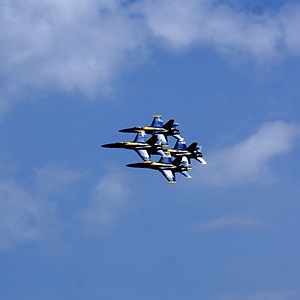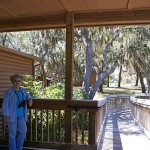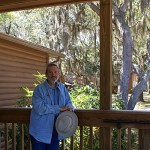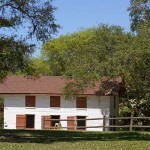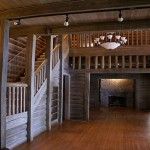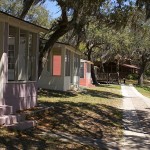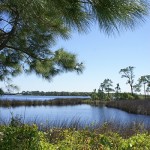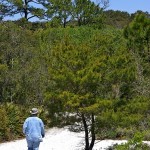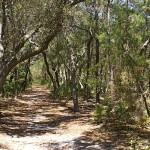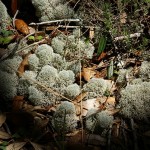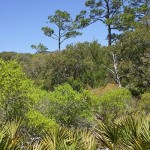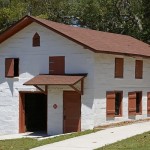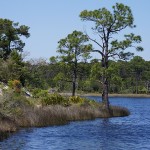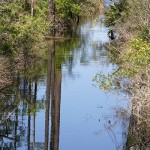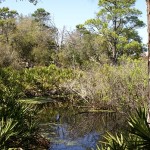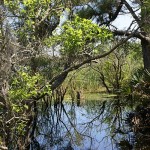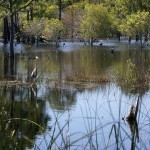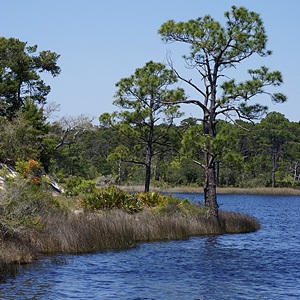No, we have not been visiting religious resale shops. Today we drove US-98 west all the way to Pensacola, Florida to visit the Pensacola Naval Air Station (NAS). Along the way we stopped at the Panera in Sandestin again. The outlet mall shops were not open yet so there was very little traffic and not much of a crowd. We took 20 minutes to enjoy some coffee and a bagel before continuing on to Pensacola. The 100 mile trip was probably a little slower than taking I-10, but it was a leisurely, pleasant drive that allowed us to take in the coastal sights. Photographs from today are in a separate gallery post.
As we got to the end of the bay bridge we did not see a sign for the Pensacola NAS so we picked our way through downtown and finally pulled into a Walmart parking lot where we put the address in our GPS. As soon as we resumed driving we saw a sign for the NAS and Museum and the GPS wanted us to take a different route. In this instance the signs won, although the GPS way would also have worked as the NAS has a front and rear entrance and our destination was closer to the rear entrance.
The Pensacola NAS is the U. S. Navy’s primary flight training facility and is home to the Naval Aviation Museum and The Blue Angels Navy Combat Fighter Flight Demonstration Squadron. The Blue Angels’ practice sessions on Tuesday and Wednesday are normally open to the public. They did not fly on Wednesday this week due to weather conditions so they flew today instead. The session was open to the public and the public showed up in large numbers. They started at 11:30 AM sharp (this is military stuff, after all) and flew for about one hour. The practice session consisted of the same maneuvers, in the same order, that make up the “show” The Blue Angels do almost every weekend somewhere in the country from mid-March through early November. They might repeat a maneuver or leave one out based on how the routine is going, how the equipment is performing, or the weather conditions.
The security personnel also acted as “play by play announcers,” letting the audience in their section of the grandstands know what maneuver was coming next. While we were waiting for the practice session to start they also provided information about The Blue Angels, the NAS, and answered whatever questions people had. The gentleman in our section had spent 30 years as a Naval aviator and was very knowledgeable. He also had the right personality for working the crowd.
When the flight demonstration was over we toured the Naval Aviation Museum. The museum is adjacent to the runways where the Blue Angels practice and is served by the same parking lot. While not as extensive as the Smithsonian Air and Space Museums or the Air Force Museum, it is an excellent facility with a superb collection of aircraft and artifacts focused exclusively on Naval flight operations. We took about three hours to wander through the exhibits, but you could easily spend two or three days here if you wanted to read every placard and study the displays more carefully. Admission to The Blue Angels practice session and the Naval Aviation Museum are both free. The museum has an IMAX theater, flight simulators, and other attractions that charge a fee.
We left the NAS around 3:30 PM via the rear gate and headed west towards Perdido Key. Along the way we found the entrance to Big Lagoon SP and went in to check it out. We had heard about BLSP from Jimmy and Sadie Clay, who spent March there as volunteer campground hosts. (I did an article on their converted bus, the Iron Horse, which appeared as the cover/centerfold story in the April 2014 issue of Bus Conversion Magazine.)
From BLSP we continued west to Perdido Key. Just past the entrance to Perdido Key SP was the Perdido Key Visitor and Community Center, which housed the Perdido Key Chamber of Commerce offices. Four miles down the road was the Alabama State line. Our reason for stopping here was that Jimmy and Sadie had mentioned that their daughter was the director of the Perdido Key Chamber of Commerce and we thought it would be fun to meet her. She was there (Tina Morrison) and we introduced ourselves and chatted for a few minutes. They pulled up the website for Bus Conversion Magazine on a computer and there was the Iron Horse on the cover! We got a nice map of the greater Pensacola area to help guide us back to I-10 using parkways on the west side if town, thus avoiding downtown during the late afternoon. The drive back on I-10 was through heavily wooded rolling terrain with light traffic. I was still tired from my night of no sleep earlier in the week and nodded off while Linda drove.
After a simple dinner Linda read while I processed photos from yesterday and today. I updated a plug-in on all four of the WordPress sites I run and got my personal blog post for yesterday uploaded, but not the photographs. The rain started around 9 PM and quickly intensified. It did not take long for the bedroom vent-fan leak to re-appear. A powerful low pressure center south of Pensacola was pulling copious amounts of moisture north into Florida, Alabama, and Georgia. This was forecast to be a long-duration rain event, but without severe storms. River flood watches and warnings continued for the area along with urban flash flood warnings and high surf and rip current warnings for the coastal beaches. We decided to put a pot on the end of the bed to catch the drips from the leak and slept on the couches. I guess that’s a good reason to keep a sleeper sofa big enough for two when we redo the living room and dinette.
